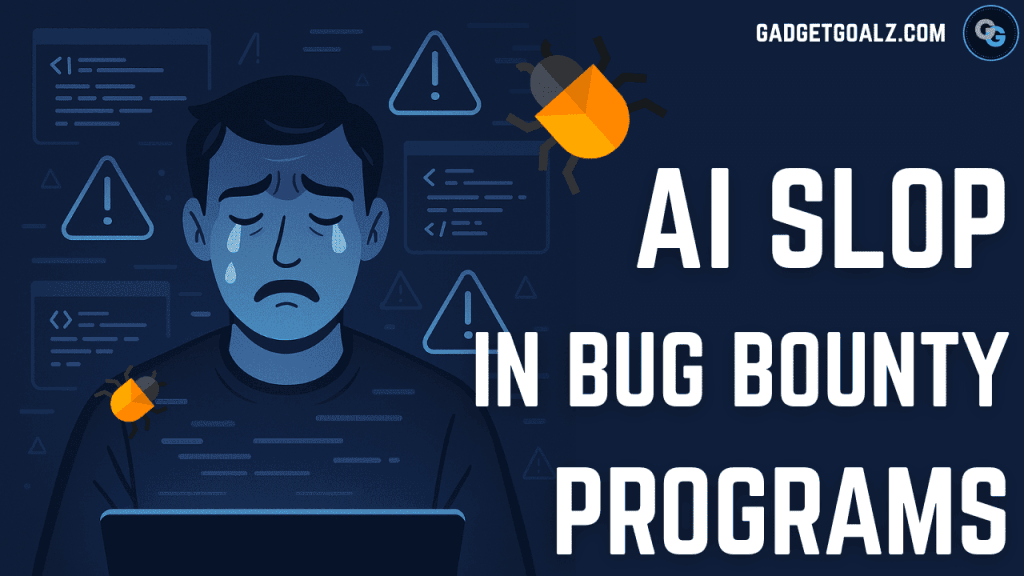
AI Slop in Bug Bounty Programs is increasingly challenging bug bounty platforms like HackerOne, Bugcrowd, Synack, Intigriti, and Open Bug Bounty. Bug bounty programs have revolutionized cybersecurity by crowd-sourcing vulnerability discovery to expert researchers worldwide. Learn how smarter triage, strict proof-of-concept rules, and researcher education are key to restoring trust and protecting these vital ecosystems
However, in 2025, these programs face a growing threat from an unexpected source: AI slop. This term describes the surge of low-effort, AI-generated bug bounty reports that waste valuable triager time, drown out meaningful submissions, and undermine trust across the bug bounty ecosystem.
This article delves deep into what AI slop is, why it’s a problem for bug bounty platforms, and practical solutions the industry can adopt to maintain high standards—while responsibly leveraging AI’s power.
What Is AI Slop in Bug Bounty Programs?
AI slop refers to bug bounty reports drafted primarily by large language models (LLMs) like ChatGPT with little to no real security analysis behind them. These reports often:
- Contain vague, generic vulnerability descriptions lacking context
- Fail to provide any proof-of-concept (PoC), exploit code, or reproducible steps
- Include common textbook definitions copy-pasted without real verification
- Use technical jargon and buzzwords to appear legitimate
- Sometimes hallucinate entirely non-existent vulnerabilities
At a glance, the language may seem professional—but deep triage quickly reveals a hollow core.
Daniel Stenberg, creator of the famous Curl project bug bounty, described experiencing a 20% AI slop submission rate in 2025, with only about 5% of reports being genuine vulnerabilities—down significantly from previous years. The flood of AI slop wastes precious time, exhausting triagers who must sift through mostly noise to find real flaws.
Leading platforms like HackerOne and Bugcrowd acknowledge the increasing volume of AI-generated low-quality reports, underlining the need to tackle the problem urgently.
Why AI Slop Threatens Bug Bounty Effectiveness
1. Wasted Triage Effort and Delays
Every bug report must be analyzed by skilled security triagers who verify findings, reproduce PoCs, and assess impact. AI slop increases workload dramatically, with multiple team members spending hours on essentially useless reports. This delays triage of legitimate bugs and frustrates security teams.
2. Eroded Trust Between Researchers and Platforms
When a significant portion of valid submissions plummets due to AI spam, trust in the bounty system suffers. Genuine researchers may face skepticism or increased bureaucracy. Organizations lose confidence in crowd-sourced security efforts.
3. Increased Costs and Reduced ROI
Analyzing AI slop wastes resources that could be dedicated to fixing genuine vulnerabilities. Platforms and companies see diminished returns on investment in bug bounty programs.
Real-World Examples and Industry Impact
- The Curl project bounty program, outsourced to HackerOne, is seriously considering reforms after continuous AI slop to protect maintainers from burnout.
- Other open source projects, including those hosted on Open Collective, report flooding by AI-generated garbage submissions, some pulling their programs entirely.
- Security researchers documented how fabricated reports mimic plausible findings but crumble under scrutiny, damaging program credibility.
6 Effective Ways to Fix Low-Effort AI Reports and Protect Your Program
1. Smarter AI-Powered Triage & Detection Tools
Platforms can deploy AI-based filters trained to identify likely AI-generated, low-effort bug reports. Common telltale signs include:
- Generic, formulaic language
- No unique technical details
- Lack of working exploit code or screenshots
These filters enable triagers to focus on higher-quality submissions faster. HackerOne already employs machine learning-assisted manual review workflows to mitigate AI slop.
2. Enforce Strict Proof-of-Concept (PoC) Requirements
Bug bounty programs should require concrete evidence:
- Exploit code snippets
- Screenshots or video reproductions of the bug
- Clear, step-by-step replication instructions
AI-generated text alone can’t reliably produce or demonstrate working exploits, so these rules effectively weed out spurious reports.
3. Researcher Education & Responsible AI Guidelines
Platforms like Bugcrowd and Intigriti can publish detailed guides encouraging:
- Using AI tools for grammar and formatting help only
- Avoiding submitting AI-generated content that hasn’t been thoroughly validated
- Double-checking all AI-suggested technical claims
Educating researchers helps separate AI-assisted quality reports from AI spam, nurturing healthier bounty communities.
4. Redesign Incentives to Reward Quality Over Quantity
Reward models should prioritize:
- High-impact, well-documented vulnerabilities
- Hunters with proven track records and quality scores (already implemented partially by HackerOne)
Conversely, platforms can build penalties or slower payouts for frequent low-quality and AI slop submissions. This discourages “volume spamming” tactics.
5. Community Moderation & Peer Review
A crowdsourced vetting system empowers trusted researchers to upvote/downvote submissions before triage, improving signal-to-noise ratios. Open Bug Bounty leverages a community-led approach effectively.
6. Require Transparency Through AI-Usage Disclosure
Platforms should mandate that researchers disclose AI involvement in writing reports. Transparency:
- Builds trust
- Allows triage teams to tailor workflows
- Encourages responsible AI use
Curl’s bounty policy already recommends disclosing generative AI use to avoid misinformation.
The Future of Bug Bounties With AI: Challenges & Opportunities
While AI slop presents real challenges, AI also holds promise in enhancing bug bounty programs:
- Assisting triage through preliminary risk scoring and classification
- Helping novice researchers write clearer, structured reports
- Speeding up vulnerability discovery via AI-assisted scanning and automation
The key is responsible AI integration, not rejection. As noted by RunSybil’s CTO Vlad Ionescu, AI should be a tool that complements human insight, not replaces it.
The cybersecurity community must continue evolving the bounty ecosystem with smart filters, clear guidelines, and fair incentives to harness AI benefits while minimizing abuse.
Final Thoughts: Prioritizing Trust, Quality, and Human Expertise
AI slop isn’t a problem to ignore; it threatens the foundation of bug bounty programs worldwide. By implementing smarter triage systems, enforcing proof-of-concept, educating researchers, redesigning incentives, leveraging community review, and embracing AI transparency, the industry can turn the tide.
Bug bounty platforms—from HackerOne to Bugcrowd, Synack, and Intigriti—must lead the way to a balanced future: where AI empowers ethical hackers without burdening security teams with meaningless noise.
This balance will ensure that bug bounties continue protecting software ecosystems effectively, supporting researchers fairly, and fostering collaboration in the AI-driven digital age.
Related: AI Slop & the Boom of Hyper-Realistic, Low-Effort Content
FAQ
Q1: What is AI slop in bug bounty programs?
A1: AI slop refers to low-effort, AI-generated bug reports lacking proof-of-concept or real exploits. These flood bug bounty platforms with fake or vague vulnerabilities.
Q2: Why is AI slop a problem for bug bounty platforms?
A2: AI slop wastes triage time, delays real vulnerability validation, erodes trust, and increases program costs, threatening bug bounty effectiveness.
Q3: How are platforms like HackerOne and Bugcrowd addressing AI slop?
A3: They use AI-powered triage filters, enforce strict proof-of-concept requirements, provide researcher education on responsible AI use, and redesign incentives prioritizing quality over quantity.
Q4: Can AI still help bug bounty hunters?
A4: Yes, when responsibly applied for report clarity, grammar, and structured findings. Problems arise when AI replaces actual vulnerability research or fabricates exploits.
Q5: What can researchers do to avoid submitting AI slop?
A5: Researchers should validate all AI-generated content with testing, include technical proof, and disclose any AI assistance to maintain transparency and credibility.

